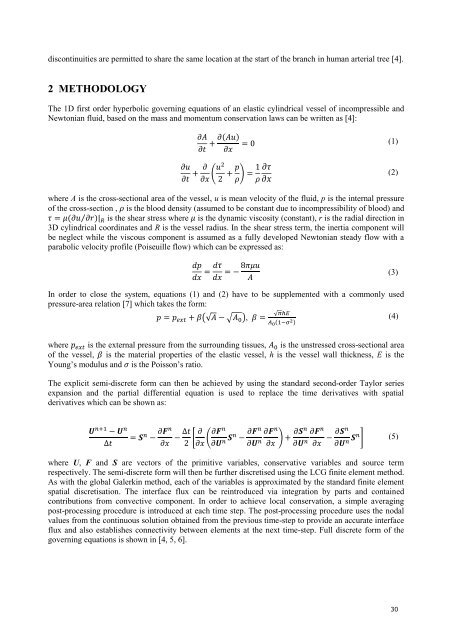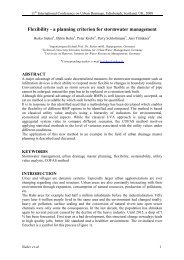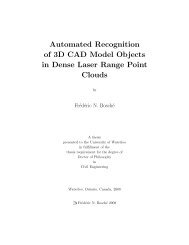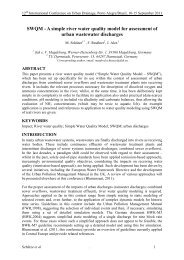ACME 2011 Proceedings of the 19 UK National Conference of the ...
ACME 2011 Proceedings of the 19 UK National Conference of the ...
ACME 2011 Proceedings of the 19 UK National Conference of the ...
You also want an ePaper? Increase the reach of your titles
YUMPU automatically turns print PDFs into web optimized ePapers that Google loves.
discontinuities are permitted to share <strong>the</strong> same location at <strong>the</strong> start <strong>of</strong> <strong>the</strong> branch in human arterial tree [4].<br />
2 METHODOLOGY<br />
The 1D first order hyperbolic governing equations <strong>of</strong> an elastic cylindrical vessel <strong>of</strong> incompressible and<br />
Newtonian fluid, based on <strong>the</strong> mass and momentum conservation laws can be written as [4]:<br />
where A is <strong>the</strong> cross-sectional area <strong>of</strong> <strong>the</strong> vessel, u is mean velocity <strong>of</strong> <strong>the</strong> fluid, p is <strong>the</strong> internal pressure<br />
<strong>of</strong> <strong>the</strong> cross-section , is <strong>the</strong> blood density (assumed to be constant due to incompressibility <strong>of</strong> blood) and<br />
is <strong>the</strong> shear stress where is <strong>the</strong> dynamic viscosity (constant), r is <strong>the</strong> radial direction in<br />
3D cylindrical coordinates and R is <strong>the</strong> vessel radius. In <strong>the</strong> shear stress term, <strong>the</strong> inertia component will<br />
be neglect while <strong>the</strong> viscous component is assumed as a fully developed Newtonian steady flow with a<br />
parabolic velocity pr<strong>of</strong>ile (Poiseuille flow) which can be expressed as:<br />
In order to close <strong>the</strong> system, equations (1) and (2) have to be supplemented with a commonly used<br />
pressure-area relation [7] which takes <strong>the</strong> form:<br />
where is <strong>the</strong> external pressure from <strong>the</strong> surrounding tissues, is <strong>the</strong> unstressed cross-sectional area<br />
<strong>of</strong> <strong>the</strong> vessel, is <strong>the</strong> material properties <strong>of</strong> <strong>the</strong> elastic vessel, h is <strong>the</strong> vessel wall thickness, E is <strong>the</strong><br />
Young’s modulus and is <strong>the</strong> Poisson’s ratio.<br />
The explicit semi-discrete form can <strong>the</strong>n be achieved by using <strong>the</strong> standard second-order Taylor series<br />
expansion and <strong>the</strong> partial differential equation is used to replace <strong>the</strong> time derivatives with spatial<br />
derivatives which can be shown as:<br />
where U, F and S are vectors <strong>of</strong> <strong>the</strong> primitive variables, conservative variables and source term<br />
respectively. The semi-discrete form will <strong>the</strong>n be fur<strong>the</strong>r discretised using <strong>the</strong> LCG finite element method.<br />
As with <strong>the</strong> global Galerkin method, each <strong>of</strong> <strong>the</strong> variables is approximated by <strong>the</strong> standard finite element<br />
spatial discretisation. The interface flux can be reintroduced via integration by parts and contained<br />
contributions from convective component. In order to achieve local conservation, a simple averaging<br />
post-processing procedure is introduced at each time step. The post-processing procedure uses <strong>the</strong> nodal<br />
values from <strong>the</strong> continuous solution obtained from <strong>the</strong> previous time-step to provide an accurate interface<br />
flux and also establishes connectivity between elements at <strong>the</strong> next time-step. Full discrete form <strong>of</strong> <strong>the</strong><br />
governing equations is shown in [4, 5, 6].<br />
,<br />
(1)<br />
(2)<br />
(3)<br />
(4)<br />
(5)<br />
30













